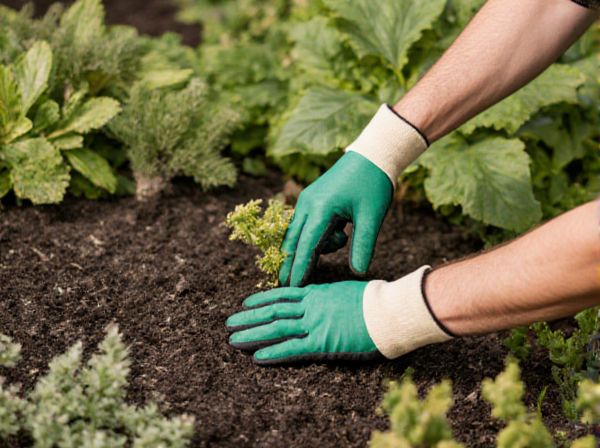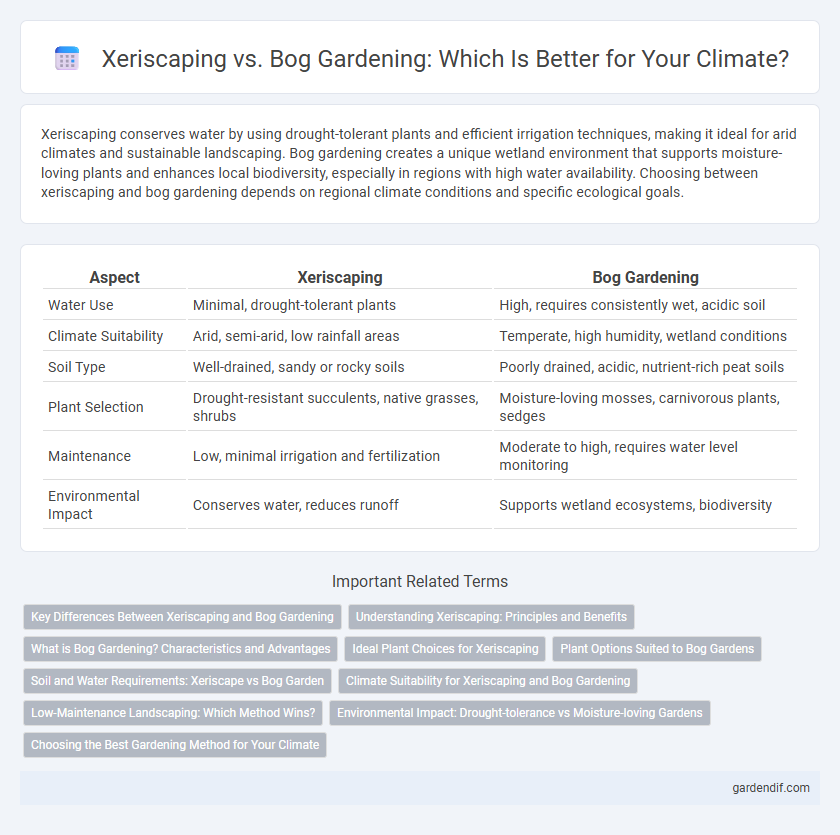
Xeriscaping vs Bog gardening Illustration
Xeriscaping conserves water by using drought-tolerant plants and efficient irrigation techniques, making it ideal for arid climates and sustainable landscaping. Bog gardening creates a unique wetland environment that supports moisture-loving plants and enhances local biodiversity, especially in regions with high water availability. Choosing between xeriscaping and bog gardening depends on regional climate conditions and specific ecological goals.
Table of Comparison
| Aspect | Xeriscaping | Bog Gardening |
|---|---|---|
| Water Use | Minimal, drought-tolerant plants | High, requires consistently wet, acidic soil |
| Climate Suitability | Arid, semi-arid, low rainfall areas | Temperate, high humidity, wetland conditions |
| Soil Type | Well-drained, sandy or rocky soils | Poorly drained, acidic, nutrient-rich peat soils |
| Plant Selection | Drought-resistant succulents, native grasses, shrubs | Moisture-loving mosses, carnivorous plants, sedges |
| Maintenance | Low, minimal irrigation and fertilization | Moderate to high, requires water level monitoring |
| Environmental Impact | Conserves water, reduces runoff | Supports wetland ecosystems, biodiversity |
Key Differences Between Xeriscaping and Bog Gardening
Xeriscaping emphasizes water conservation by using drought-resistant plants and efficient irrigation techniques, suited for arid climates. Bog gardening thrives in consistently wet, acidic conditions, featuring moisture-loving plants like carnivorous species and certain shrubs. These approaches differ fundamentally in water management, plant selection, and soil requirements, catering to contrasting environmental conditions and conservation goals.
Understanding Xeriscaping: Principles and Benefits
Xeriscaping is a water-efficient landscaping method designed to reduce or eliminate the need for irrigation by using drought-tolerant plants native to arid regions. Key principles include soil analysis, strategic plant selection, efficient irrigation techniques, and mulching to retain soil moisture. This approach conserves water resources, lowers maintenance costs, and mitigates the impact of climate change by promoting sustainable land use in drought-prone areas.
What is Bog Gardening? Characteristics and Advantages
Bog gardening involves cultivating moisture-loving plants in water-saturated, acidic soil that mimics natural wetland environments. Key characteristics include consistently damp conditions, a rich presence of sphagnum moss, and a unique ecosystem supporting carnivorous plants and moisture-dependent species. Advantages of bog gardening encompass enhanced biodiversity, natural water filtration, and suitability for climates with high humidity or poor drainage.
Ideal Plant Choices for Xeriscaping
Ideal plant choices for xeriscaping emphasize drought-tolerant species such as succulents, cacti, agave, and native grasses that thrive with minimal water. These plants possess deep root systems and waxy leaves to reduce water loss, making them highly efficient in arid landscapes. Incorporating Mediterranean herbs like lavender and rosemary further enhances a xeriscape's resilience and visual appeal while conserving water resources.
Plant Options Suited to Bog Gardens
Bog gardening thrives with moisture-loving plants such as pitcher plants (Sarracenia), sundews (Drosera), and marsh marigolds (Caltha palustris). These plants are adapted to saturated, acidic soils and provide vibrant, lush greenery that supports diverse wildlife, including amphibians and pollinators. Selecting native bog plants enhances ecosystem resilience and preserves local biodiversity in wetland garden environments.
Soil and Water Requirements: Xeriscape vs Bog Garden
Xeriscaping relies on drought-tolerant plants and well-draining, sandy or rocky soils that minimize water use, making it ideal for arid climates. In contrast, bog gardening requires consistently moist, acidic soils with high organic matter to support hydrophilic plants. Water conservation is a primary benefit of xeriscaping, whereas bog gardens depend on stable water levels, often needing supplemental irrigation or natural groundwater sources.
Climate Suitability for Xeriscaping and Bog Gardening
Xeriscaping thrives in arid and drought-prone climates by utilizing drought-resistant plants and efficient water management techniques, significantly reducing irrigation needs. Bog gardening is best suited for cool, wet, and humid climates where soil remains consistently moist, supporting water-loving plants like carnivorous species and moisture-dependent perennials. Selecting xeriscaping or bog gardening depends on local precipitation patterns, soil moisture retention, and temperature ranges to ensure plant survival and ecosystem sustainability.
Low-Maintenance Landscaping: Which Method Wins?
Xeriscaping promotes water conservation by utilizing drought-tolerant plants and efficient irrigation, making it ideal for arid climates with minimal maintenance needs. Bog gardening requires consistent moisture levels and specialized soil conditions, often demanding more attention and resources to maintain plant health. For sustainable, low-maintenance landscaping, xeriscaping generally outperforms bog gardening in reducing water usage and upkeep efforts.
Environmental Impact: Drought-tolerance vs Moisture-loving Gardens
Xeriscaping conserves water by using drought-tolerant plants, significantly reducing irrigation needs and minimizing strain on municipal water supplies. Bog gardening supports biodiversity by providing a natural habitat for moisture-loving plants and wildlife, contributing to wetland ecosystem preservation. Both practices offer sustainable environmental benefits by adapting to local climate conditions, either through water conservation or fostering moisture-rich habitats.
Choosing the Best Gardening Method for Your Climate
Xeriscaping thrives in arid and drought-prone climates by utilizing drought-resistant plants and water-efficient landscaping techniques to conserve moisture and reduce irrigation needs. Bog gardening suits wet, acidic environments where water-saturated soils support moisture-loving plants like carnivorous species and sedges. Selecting the best gardening method depends on assessing local rainfall patterns, soil moisture levels, and native plant adaptability to ensure sustainable landscape management.
Xeriscaping vs Bog gardening Infographic

 gardendif.com
gardendif.com